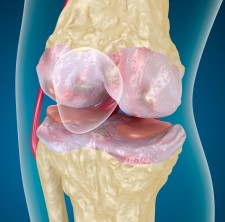 Osteoarthritis via Shutterstock
Osteoarthritis via Shutterstock
Researchers from the Medical University of Vienna have been looking into the role of proteins called galectins, which are prevalent in the joint cartilage of patients with osteoarthritis (OA). Until very recently, it was unknown what role galectins played in OA.
Recently featured as a “Research Highlight” in the journal Nature Reviews Rheumatology, the work of scientists from the University Department of Orthopedics has revealed that the protein, galectin-1, is positively correlated with the level of degeneration propagated by the inflammation of OA. The worse the level of joint degeneration, the greater the presence of the protein.
It was still a question, however, whether the damage preceded the expression of this protein or if the presence of the protein elicited the destructive inflammation.
“For the very first time our study showed that galectin-1 triggers inflammation rather than the inflammation triggering secretion of this protein,” according to Dr. Stefan Togel, one of the study’s authors. This is clinically very important because it can serve as a potential therapeutic target for the future treatment of OA.
Galectins are a family of carbohydrate binding proteins that mediate cell-cell or cell-matrix (outer environment) interactions. Galectin-1 seems to have a wide range of biological activity and is present in both normal and pathological tissues. According to the feature article, with regard to OA, galectin-1 is a master regulator of the degeneration of cartilage cells, chondrocytes, by activating a pro-inflammatory pathway known as nuclear factor-ĸB (NFĸB). Interestingly, galectin-1 plays a paradoxical role in rheumatoid arthritis, where it exerts a protective anti-inflammatory effect.
Upon examination of samples of knee joint cartilage from 29 subjects, the researchers observed that once galectin-1 was bound to the chondrocyte cell surface there was a subsequent increase in the expression of factors that cause the breakdown of the extracellular matrix (the material that fills the space between the cells of tissues).
Dr. Togel also stated, “However, what we still don’t know is the answer to the question: why is galectin-1 so strongly expressed in the first place?” This will be the foundation for future research.
OA is a common type of arthritis which results in a gradual loss of the cartilage in joints resulting in pain, stiffness, loss of range of motion and changes in the shape of the affected joints. It most commonly affects the hands, knees, hips and spine, though it can affect almost any joint. OA has always been considered a condition associated with aging (wear and tear), however, there exists a complex interplay of several factors involved in its development – joint integrity, genetic predisposition, local inflammation, mechanical force, and cellular and biochemical processes.
Considering that OA is a chronic, progressive condition with no cure, the main approach to treatment has been to slow the progression of disease and control the symptoms. For the estimated 27 million Americans who have OA, any potential treatment to prevent the destructive nature of this disease will be extremely welcome.



